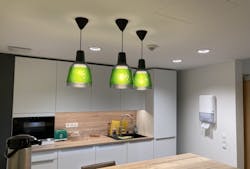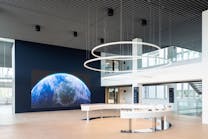More factory closures, consolidations likely at Signify as margins improve
Quarterly sales and earnings declined again at Signify but gross margins improved, as CEO Eric Rondolat said the company continues cutting costs through a variety of measures including factory closures and consolidations. He hinted that U.S. plant shutdowns could be coming.
Nominal sales fell 13.8% to €1.65 billion ($1.75 billion) from €1.91 billion ($2.01 billion) in the third quarter ending Sept. 30, compared to the same quarter a year ago, including a negative 6.2% currency impact. The comparable sales decline was 7.8%. Net income dropped by 25.5%, €83 ($87.9) million from €112 million ($118.6 million).
“Our top line was impacted by continued softness in our markets, particularly in consumer connected, OEM, and China,” Rondolat told analysts on a web call to discuss the results. His remarks echoed his observations from the second quarter three months ago. In both instances, he also reported gains in outdoor professional lighting but softness in sales of indoor professional lighting and in the horticultural sector.
“During the [third] quarter we saw strength in professional systems and services, which was more than offset by weakness in indoor professional lighting, particularly horticulture lighting,” Rondolat told analysts this morning. Sales also tumbled in the company’s conventional business segment, which includes fluorescent and makes up about 10% of overall sales.
On the positive side, Signify stuck with its forecasted adjusted EBITA margin of 9.5%–10.5% for the year, rather than downgrading the forecast, as it did in the second quarter.
“Despite pressure on the top line, we were able to expand our adjusted EBITA margin by 30 basis points year-on-year, driven by continued gross margin recovery and cost discipline,” Rondolat told analysts, noting that EBITA margin rose to 10.7% from 10.4% a year earlier. ”This was driven by the continued improvement of our gross margin, which benefited from effective measures to reduce the cost of goods sold and indirect costs.”
Rondolat said that ongoing cost measures will include “structural” ones such as cutbacks in the Eindhoven, Netherlands–based company’s central organization.
They will also include additional shutdowns of factories, which Rondolat characterized as a change in the global factory “footprint.” In one such maneuver over the summer, Signify announced a massive expansion of facilities at Zhejiang Klite Lighting Holdings Co., Ltd. in China. Klite is a joint venture partner. It makes lamps that Signify sells under the Philips brand and also for OEM sale to retailers for private label, mostly in the consumer market, although also in professional.
“The footprint is an evolving situation,” the Signify boss said in response to an analyst’s question today. “We’ve had the closure of some factories in the conventional part of the business, which is something we do on a regular basis. Smaller factories doing components, we try to move this production to other established factories. That’s on ongoing adjustment. [With] Klite, the objective was to concentrate the lamps production business in one big factory.”
More closures are coming.
“We believe, in the midterm, the evolution of our footprint should continue to improve, quite substantially, our gross margin expansion, especially in northern America,” Rondolat said. “We believe that we have some points to gain from moving some of the various remaining factories or remaining industrial set-ups that would be in high-cost countries to lower-cost countries. We are looking at that as we speak.”
LEDs Magazine asked Signify in an email if that means closures are in store for North American factories. A spokesperson replied, “To your question on North America, we have 8 factories in the U.S. and 2 in Canada.” She did not elaborate on their future.
Signify has a total of 47 factories globally.
Overall in costs, “we’re not not where we want to be,” Rondolat said on the analysts’ call. “That’s the reason why we want to drive more specific actions.” Ongoing measures “will little by little have an effect on our overall cost base,” he added.
Headcount across the company was down to 32,214, from 34,273 a year ago.
During today’s call, Rondolat noted that while the company continues to steadily grow its base of “connected” lights, it has so far not monetized these networks in hoped-for IoT schemes.
For the second quarter in a row, he also acknowledged that the company needs measures to reverse the decline in its connected home products such as Hue, where Signify’s prices are well above competitors’. Rondolat also elaborated on how Europe’s fluorescent ban is impacting the company, and on progress in Signify’s sustainability and equality initiatives.
LEDs will dive into some of these topics in separate articles.
MARK HALPER is a contributing editor for LEDs Magazine, and an energy, technology, and business journalist ([email protected]).
Follow our LinkedIn page for our latest news updates, contributed articles, and commentary, and our Facebook page for events announcements and more. You can also find us on the X platform.
Mark Halper | Contributing Editor, LEDs Magazine, and Business/Energy/Technology Journalist
Mark Halper is a freelance business, technology, and science journalist who covers everything from media moguls to subatomic particles. Halper has written from locations around the world for TIME Magazine, Fortune, Forbes, the New York Times, the Financial Times, the Guardian, CBS, Wired, and many others. A US citizen living in Britain, he cut his journalism teeth cutting and pasting copy for an English-language daily newspaper in Mexico City. Halper has a BA in history from Cornell University.





